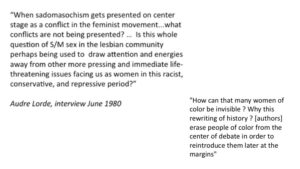for Digital Humanities and Gender History February 5, 2021
I’m here today to talk to you about something I call historical altmetrics — an effort to find different ways of understanding influence in the past in order to incorporate individuals that scholars have too often relegated to the margins of history. Historical Altmetrics aims to upend the historiographical hierarchies. Even if you are not particularly interested in the case study at the center of my book, the women’s liberation movement of the Anglophone world, this talk still has something for you. Doing gender history using tools borrowed from the digital humanities gives everyone something to think about.
At each step in historical altmetrics there is a challenge both for the researcher and the field of DH. We have been taught since the earliest ages what matters in history and more importantly whose history matters. How does the use of digital approaches re-inscribe those priorities? How can I compile custom corpora when what gets digitized reflects scholarly priorities that do not value the historical actors who most interest me? How can I attend to the biases inherent in digital tools as I write histories of race and gender? Even as I produce readings of the texts how do I decenter dominant voices that threaten to drown out others? Where do I fit as the researcher, telling stories of other people, stories that are not necessarily mine to tell?
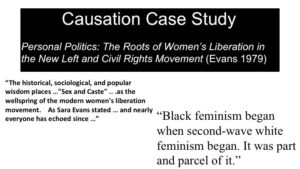 My first case study looks at Causation. This historiography starts with Sara Evans argument about the origins of the women’s liberation movement in the United States. Since its publication in 1979, Evans has become the accepted account of a causal history that places a single document, “A Kind of Memo” by Casey Hayden and Mary King, written in 1965, as the origin of 1970s feminism. Causation relies on examining when something happened which often has a who and a where attached to it. This led me to a specific type of computer software, Entity recognition finds variables like names, dates, and places in texts. Entity recognition has the potential to shift attention away from the already-acknowledged central figures in a history, the names that are looking for when we go into archival sources, by finding less-familiar names that may be harder to track across many dispersed historical documents. Entity recognition is complicated by many gendered factors of naming conventions including marital status and habits of referring to women by first names not last names, which makes disambiguating them more difficult. In this case, Casey Hayden’s birth name is Sandra Cason. Her nickname is Casey and she married a man named Tom Hayden, who appears himself as a historical actor in many texts.
My first case study looks at Causation. This historiography starts with Sara Evans argument about the origins of the women’s liberation movement in the United States. Since its publication in 1979, Evans has become the accepted account of a causal history that places a single document, “A Kind of Memo” by Casey Hayden and Mary King, written in 1965, as the origin of 1970s feminism. Causation relies on examining when something happened which often has a who and a where attached to it. This led me to a specific type of computer software, Entity recognition finds variables like names, dates, and places in texts. Entity recognition has the potential to shift attention away from the already-acknowledged central figures in a history, the names that are looking for when we go into archival sources, by finding less-familiar names that may be harder to track across many dispersed historical documents. Entity recognition is complicated by many gendered factors of naming conventions including marital status and habits of referring to women by first names not last names, which makes disambiguating them more difficult. In this case, Casey Hayden’s birth name is Sandra Cason. Her nickname is Casey and she married a man named Tom Hayden, who appears himself as a historical actor in many texts.
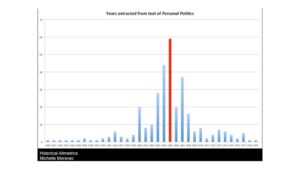 Hayden is the single most mentioned individual in Evans text and 1965, the date of Sex and Caste, highlighted in red, is the most invoked date although this some three years before the groups Evans’ identifies as the start of women’s liberation are even founded. While Evans’ conducted extensive interviews with movement participants in the 1970s, she did not rely on the very early periodicals to emerge from women’s liberation. These then provide me with historical documents to use in evaluating her emphasis about Sex and Caste. What computational evidence exists for early participations writing about or even distributing Sex and Caste provides a means for quantifying the causal influence it had beyond the well-known figures Evans interviewed.
Hayden is the single most mentioned individual in Evans text and 1965, the date of Sex and Caste, highlighted in red, is the most invoked date although this some three years before the groups Evans’ identifies as the start of women’s liberation are even founded. While Evans’ conducted extensive interviews with movement participants in the 1970s, she did not rely on the very early periodicals to emerge from women’s liberation. These then provide me with historical documents to use in evaluating her emphasis about Sex and Caste. What computational evidence exists for early participations writing about or even distributing Sex and Caste provides a means for quantifying the causal influence it had beyond the well-known figures Evans interviewed.
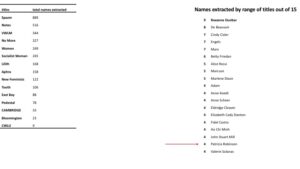 This leads to a second set of problems that doing a history of gender highlights for the digital humanities – texts that are suitable for machine readings are not widely available for historical actors who have been marginalized by the structures that both preserve historical sources and decided which are deserving of digitization. My movement periodical corpus contains roughly 10% of the known feminist periodicals from 1970-1990. Working with fifteen periodicals c 1968 and 1969, entity recognition results from these periodicals indicates that Hayden and King may not be deserving of such a central place in the origin story of women’s liberation. Influence may be viewed two ways through these digital results, names extracted from a particular title gives insights into the most influential individuals for a particular periodical. These results suggest that we should attend more carefully to the local contexts as there is little overlap among the results. However, if we look at names aggregated across titles, by the range of titles out of 15 in which an individual appears, some historical influencers start to become more apparent. Most significantly, this process emphasized the centrality of documents by one group of Black women in Mt. Vernon new York who while not unknown to the literature have yet to be incorporated in significant enough ways to challenge the accepted wisdom of Evans’ account which starts the women’s liberation movement with a document written by two white women.
This leads to a second set of problems that doing a history of gender highlights for the digital humanities – texts that are suitable for machine readings are not widely available for historical actors who have been marginalized by the structures that both preserve historical sources and decided which are deserving of digitization. My movement periodical corpus contains roughly 10% of the known feminist periodicals from 1970-1990. Working with fifteen periodicals c 1968 and 1969, entity recognition results from these periodicals indicates that Hayden and King may not be deserving of such a central place in the origin story of women’s liberation. Influence may be viewed two ways through these digital results, names extracted from a particular title gives insights into the most influential individuals for a particular periodical. These results suggest that we should attend more carefully to the local contexts as there is little overlap among the results. However, if we look at names aggregated across titles, by the range of titles out of 15 in which an individual appears, some historical influencers start to become more apparent. Most significantly, this process emphasized the centrality of documents by one group of Black women in Mt. Vernon new York who while not unknown to the literature have yet to be incorporated in significant enough ways to challenge the accepted wisdom of Evans’ account which starts the women’s liberation movement with a document written by two white women.
Why does this matter? The tenacity of Evans’ interpretation the status it has as the received wisdom or standard account has significant implications for feminism today which traces its origins in many cases to the 1970s activists. This current narrative anchors the birth of women’s liberation in white women’s negative emotional responses within the black freedom moment. Hayden and King’s memo is often mistakenly described as eliciting Stokely Carmichael’s infamous quip that the only position for women in the civil rights movement was on their backs. This attribution is not only factually incorrect, that remark occurred in 1964 in regards to a different document that Hayden and King co-authored with two other women, but it also misrepresents the moment, which has been thoroughly contextualized by women present at the time. This conflation is more than a mistake. It is part and parcel of a larger narrative that white women were oppressed by black men within the civil rights movement and that experience both simultaneously raised their consciousness and propelled them into a movement of their own. It also provides the foundation for white feminists claims, framed by the appropriation of the language of black power and through analogies that equated women with Blacks, that their autonomous movement was as justified as the movement to end racism.
Not only is this standard narrative centered on white women’s feelings, this interpretation prioritizes the early split from civil rights over the continuing interplay of women’s liberation and black power. At its most damaging, this causal narrative centered on Sex and Caste leaves no space for groups like the Mt. Vernon one or for black women who continued to participate in groups like SNCC but also formed women’s committees within that organization. These contributions have been perpetually sidelined or described as a response to white women’s feminism because of the tenacity of a narrative that is so firmly rooted in the 1965 memo.
Evans’ interpretation appeared in 1979 at the moment when the master narrative of women’s history was being formed. In this account, the significance of women’s liberation relies in large part on its relation to the civil rights movement and through the tidy historical parallels with abolition and the nineteenth woman rights movement. Thus above all the results of historical altmetrics suggests a more complex causation that attends to the dynamics of power relations in the past, It requires scholars to to wean themselves from over reliance on “firsts” to dig deeper. Finally it involves the very hard work of creating a causal narrative that resists establishing the historical significance of feminist activism by anchoring it to a larger “master narrative.”
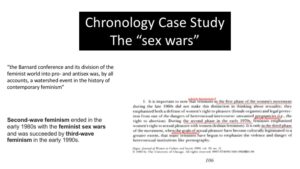 My case study comes from an example of creating meaning chronologically? Here the crucial date is 1982 when Barnard College held the Scholar and the Feminist conference on sexuality. This conference is generally positioned as the central event of the “sex wars” Depending on who you ask, the battles in the sex wars involved many different topics in relation to sexuality, but the most central were pornography and sadomasochism. Sometimes 1982 is position as the transition from the second to third waves of feminism, while in other cases it is blamed for fragmenting or ending the second wave. No matter what interpretive weight it carries, however, 1982 is a central temporal marker.
My case study comes from an example of creating meaning chronologically? Here the crucial date is 1982 when Barnard College held the Scholar and the Feminist conference on sexuality. This conference is generally positioned as the central event of the “sex wars” Depending on who you ask, the battles in the sex wars involved many different topics in relation to sexuality, but the most central were pornography and sadomasochism. Sometimes 1982 is position as the transition from the second to third waves of feminism, while in other cases it is blamed for fragmenting or ending the second wave. No matter what interpretive weight it carries, however, 1982 is a central temporal marker.
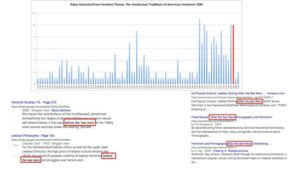 In order to know something has changed over time, we need a before and after Because periodization rests on an implicit comparison, a specific statistic within computational linguistics keyness provides a good way to quantify this change. Keyness measures the extent to which one set of texts differs from another at a statistically significant rate. I first attempted to use keyness to measure trends in content through a semantic tagger, but the lexicon underneath did not reflect feminist uses of words. While I loved that women was coded as the first sex S2.1 and men as the S2.2, the conflation of things like anger and violence as a single tag did not work well for discourses that addressed violence against women. I then realized that the variant ways terms in this debate were framed (porn, porno, porny not to mention the use of hyphens ampersands and periods in various references to sadomasochism) meant that I needed to be able to constantly verify the word in context. That led to me to a more basic corpus analysis tool. However my tool problems were compounded by even bigger corpus problems than I had looking at the causation case study. Thirty-two titles in my corpus ended before 1982. Eight more periodicals lasted until 1984 and additional eight continued until the late 1980s or into the 1990s.
In order to know something has changed over time, we need a before and after Because periodization rests on an implicit comparison, a specific statistic within computational linguistics keyness provides a good way to quantify this change. Keyness measures the extent to which one set of texts differs from another at a statistically significant rate. I first attempted to use keyness to measure trends in content through a semantic tagger, but the lexicon underneath did not reflect feminist uses of words. While I loved that women was coded as the first sex S2.1 and men as the S2.2, the conflation of things like anger and violence as a single tag did not work well for discourses that addressed violence against women. I then realized that the variant ways terms in this debate were framed (porn, porno, porny not to mention the use of hyphens ampersands and periods in various references to sadomasochism) meant that I needed to be able to constantly verify the word in context. That led to me to a more basic corpus analysis tool. However my tool problems were compounded by even bigger corpus problems than I had looking at the causation case study. Thirty-two titles in my corpus ended before 1982. Eight more periodicals lasted until 1984 and additional eight continued until the late 1980s or into the 1990s.
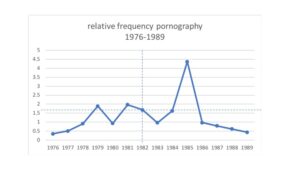 Looking at relative word frequencies over time indicates that at least in the sample titles the year 1982 takes on less significance in terms of debates over pornography. The earlier peaks of 1979 and 1981 are consistent with nuanced histories of feminist activism on this issue. This results suggests that if we re-orient ourselves away from New York City, some feminist communities had their “sex war” in the 1970s. It also indicates that while the 1982 conference might have been a moment, much debate emerged n 1985 which coincides with the year feminists helped author an anti-pornography law for the US city of Minneapolis.
Looking at relative word frequencies over time indicates that at least in the sample titles the year 1982 takes on less significance in terms of debates over pornography. The earlier peaks of 1979 and 1981 are consistent with nuanced histories of feminist activism on this issue. This results suggests that if we re-orient ourselves away from New York City, some feminist communities had their “sex war” in the 1970s. It also indicates that while the 1982 conference might have been a moment, much debate emerged n 1985 which coincides with the year feminists helped author an anti-pornography law for the US city of Minneapolis.
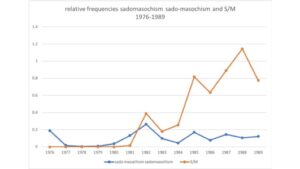 The case is less clear for sadomasochism which while already debated in some publications has a definite spike in 1982. However, as if the case with pronography, the 1982 spike is dwarfed by subsequent spikes which are reflection of the never ending discussions and debates that played out in various periodicals, If 1982 more a “bump In the road” than a definitive dividing line what is lost when we focus only on sexuality in this historical moment? The early 1980s were a significant period of change; The decline in my corpus is indicative of that if nothing else.
The case is less clear for sadomasochism which while already debated in some publications has a definite spike in 1982. However, as if the case with pronography, the 1982 spike is dwarfed by subsequent spikes which are reflection of the never ending discussions and debates that played out in various periodicals, If 1982 more a “bump In the road” than a definitive dividing line what is lost when we focus only on sexuality in this historical moment? The early 1980s were a significant period of change; The decline in my corpus is indicative of that if nothing else.
That very question was posed by Audre Lorde in 1980. Returning to my initial method of keyness, I attempted ot answer Lorde’s query about which conflicts got sidelined by a focus on the sex wars? I used corpus analysis software to generate lists of words that increased or decreased yearly.
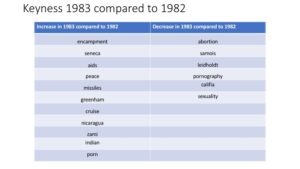 For the sake of time, I’ll highlight just the year after the 1982 conference. A decline occurs with terms and people associated with the sex wars debate because less newspaper reporting occurred as the event receded into the past. What content emerges in this year? Two significant influences surface from feminists outside the US in these US feminist periodicals. The largest comes from the Greenham Common Women’s Peace Camp that inspired US feminists to create a similar encampment in Seneca Falls. There is also evidence of US feminists becoming active in protests of US foreign policy in Nicaragua. Secondly, Zami, the title of Audre Lorde’s enormously influential biomythography pops up quite high on the new content for 1983.
For the sake of time, I’ll highlight just the year after the 1982 conference. A decline occurs with terms and people associated with the sex wars debate because less newspaper reporting occurred as the event receded into the past. What content emerges in this year? Two significant influences surface from feminists outside the US in these US feminist periodicals. The largest comes from the Greenham Common Women’s Peace Camp that inspired US feminists to create a similar encampment in Seneca Falls. There is also evidence of US feminists becoming active in protests of US foreign policy in Nicaragua. Secondly, Zami, the title of Audre Lorde’s enormously influential biomythography pops up quite high on the new content for 1983.

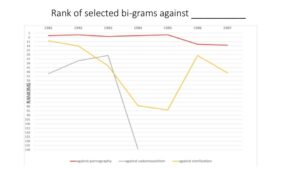 Other measures from corpus analytics can help to clarify these shifts in content over time. Cluster analysis locates word patterns formed in texts. In this case, if some feminists were against pornography what else were they also against? Interesting patterns emerged that confirm Lorde’s supposition that other concerns became sidelined by the focus on sexuality. Looking at frequency rankings for clusters formed with against illustrates that while in 1981 against racism edged out against pornography but ranked is reversed until 1986. The situation is even more dire for against sterilization a reference to the abuse of women, almost all poor women of color, by the medico-legal establishment.
Other measures from corpus analytics can help to clarify these shifts in content over time. Cluster analysis locates word patterns formed in texts. In this case, if some feminists were against pornography what else were they also against? Interesting patterns emerged that confirm Lorde’s supposition that other concerns became sidelined by the focus on sexuality. Looking at frequency rankings for clusters formed with against illustrates that while in 1981 against racism edged out against pornography but ranked is reversed until 1986. The situation is even more dire for against sterilization a reference to the abuse of women, almost all poor women of color, by the medico-legal establishment.
Lorde mentioned sterilization abuse in a significant speech she delivered 1981 that I’ll end with. What are we dividing when we periodize in 1982 or rather who is the “we” of the history that is said to break at such moments? Much as I noted about the causal narrative of Sex and Caste, periodization based on the sex wars offers an affective history. Scholars often describe the sex wars as emotionally fraught. They are a “painful” moment, but whose pain is being prioritized? The 1982 conference was only one a string of feminist conferences beginning in the 1970s that involved intense debates and acrimony. In 1981, the year before the Barnard Conference, a conference occurred that carries much more significance for another story of women’ s liberation. At the NWSA conference in Storrs, Connecticut, focused on the theme “Women respond to Racism” Lorde delivered these remarks. The speech, published as The Uses of Anger has its own painful history. The theme of this conference resulted from many years of effort by black, latina, indigenous and other feminists of color to push, cajole, and challenge white feminists, particularly those individuals who had found a home within academia and thsu secured a certain sort of status to address racism. But this conference is not generally positioned in relation to that long arc of second wave feminism which would include conferences going well back to the mid 1970s and writings published even earlier. Instead Lorde and other Black and Latina feminists become a jumping off point for the next wave of feminism emerging in the 1980s.
Following Clare Hemmings then I ask what work is done by a chronological narrative that privileges 1982 as *the* pivotal date. Dividing the line in 1982 creates a tidy barrier between bad anti porn (read racist white) feminists and a better (read racially inclusive pro sex) feminism to emerge. The narrative translocates prominent voices like Lorde’s out of the 1970s and moves them into the 1980s as an inspiration for future third wave feminists. This atemporal approach places Black feminists as out of time, ignoring that most of Lorde’s work cited from the 1970s originated as talks given at significant feminist conferences and specifically engaged issues that emerged out of activism in that decade. Historical altmetrics highlights the need to reject single event chronologies. It challenges us to resist recuperative periodization. Most significantly, it requires asking whose histories are centered in chronological accounts of feminism.



